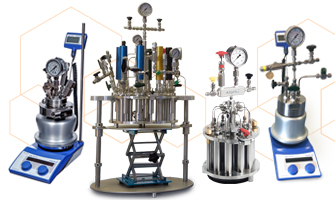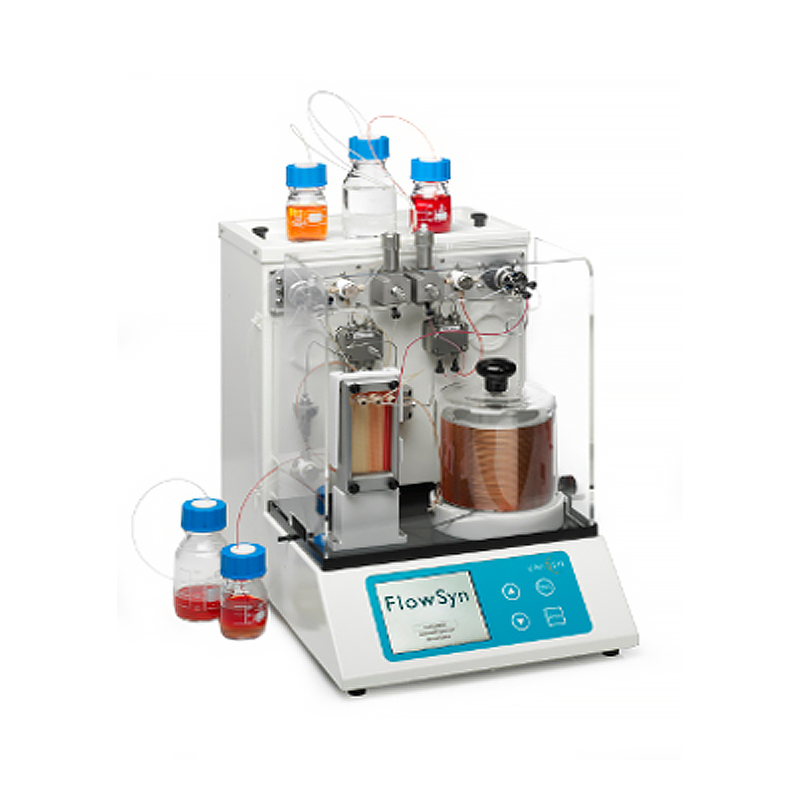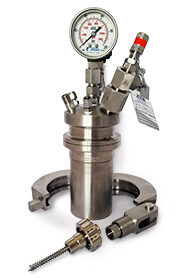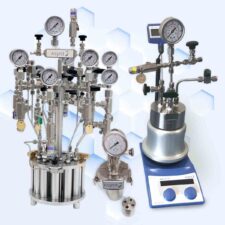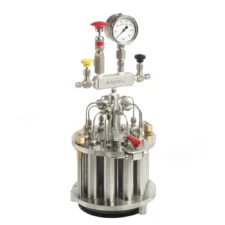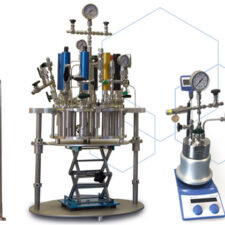Performing chemical reactions under high pressure enables processes that are otherwise challenging or unfeasible under standard atmospheric conditions.
High pressure reactors enable reactions above reflux temperatures and give safe access to gaseous chemistry, whether adding or evolving gas. This facilitates reactions such as hydrogenation, oxidation, and catalysis.
High-pressure conditions can lower activation energy barriers and increase solubility of gaseous reactants, opening new pathways for chemical synthesis. However, the extreme forces involved, especially when coupled with high temperatures, require equipment engineered for safety, precision, and durability.
Types of Pressure Reactors
- Batch reactors are sealed vessels designed to perform individual, closed reactions (with the exception of optional sampling and additions).
A selection of our batch pressure reactors, covering single position, parallel position and a range of specifications
- Flow reactors, in contrast, enable a continuous feed of reactants and product removal. Their small volumes allow for easy pressurisation. These systems suit reactions where residence time and precise control over reaction conditions are critical.
Our FlowSyn operates up to a pressure of 96 bar
Applications of High-Pressure Chemistry
High-pressure reactors have diverse applications across industry and research. Common chemical processes include:
- Hydrogenation: Widely used in food, pharmaceuticals, and petrochemicals, Hydrogenation reactions often benefit from high-pressure conditions to increase the solubility of hydrogen gas in liquid-phase systems and to optimise catalyst performance.
- Oxidation: High-pressure oxidation facilitates reactions such as the production of aldehydes, ketones, and carboxylic acids, often improving yield and selectivity.
- Polymerisation: Reactions like ethylene polymerisation to produce polyethylene are typically conducted under high pressures to achieve desired polymer characteristics.
- Cracking: High-pressure catalytic cracking is critical in the petroleum industry to break down large hydrocarbons into smaller, more valuable products like gasoline.
- Fine chemical and pharmaceutical synthesis: High-pressure conditions can enable complex transformations, such as chiral hydrogenation or cyclisation reactions, which are vital in creating active pharmaceutical ingredients (APIs).
- Catalyst research: High-pressure environments are used for testing and developing novel catalysts, particularly for gas-phase reactions involving hydrogen, carbon monoxide, or other reactive species.
- Organic synthesis: High-pressure techniques expand the synthetic toolkit, allowing chemists to perform transformations such as Diels-Alder reactions, cycloadditions, or high-pressure-induced rearrangements.
These varied applications underscore the versatility and importance of high-pressure reactors in advancing chemical innovation.

Reactor Design and Materials
Given the extreme pressures, elevated temperatures, and reactive environments encountered in high-pressure chemistry, robust and corrosion-resistant materials are essential for reactor construction.
- Batch reactors: These are typically constructed from advanced alloys such as 316 stainless steel, Hastelloy, or Inconel, chosen for their ability to withstand harsh chemical and thermal conditions. For reactions involving highly corrosive substances, the interior of the reactor can be fitted with a removable liner made from PTFE (polytetrafluoroethylene) or glass, which enhances chemical resistance while maintaining the reactor’s integrity.
- Flow reactors: The tubing and fittings used in flow systems are made from materials like 316 stainless steel, Hastelloy, or a fluoropolymer such as PTFE or PFA, which provide durability and chemical inertness under high-pressure and high-temperature conditions. Interchangeable tubing configurations allow for adaptation to specific reaction requirements, ensuring optimal performance.
In addition to materials, precise engineering ensures safety and operational efficiency. Features such as rupture discs, pressure relief valves, and, in the case of the PressureSyn, our unique clamping system are integrated into modern reactors to prevent accidents and maintain consistent reaction conditions.
PressureSyn with novel safety clamp removed. Each clamp can only be removed with a unique key which also serves as the residual pressure release, ensuring the reactor can never be opened while under pressure
Advantages of Heating Under High Pressure
Heating chemical reactions under high pressure can significantly enhance reaction rates and yields by providing sufficient thermal energy to overcome activation barriers while simultaneously maintaining reactants in their desired phase. For example, supercritical fluids such as supercritical carbon dioxide (CO₂) serve as both solvents and reactants in certain high-pressure systems, combining the properties of gases and liquids to improve mass transfer and reaction efficiency.
High-pressure heating also enables unique reaction pathways, such as those observe in hydrothermal synthesis or Fischer-Tropsch processes, where temperature and pressure synergistically drive the formation of desired products.
By using these specialised techniques and designs, high-pressure reactors are indispensable tools in modern chemical research and industrial production, enabling ground breaking advancements in chemistry.
